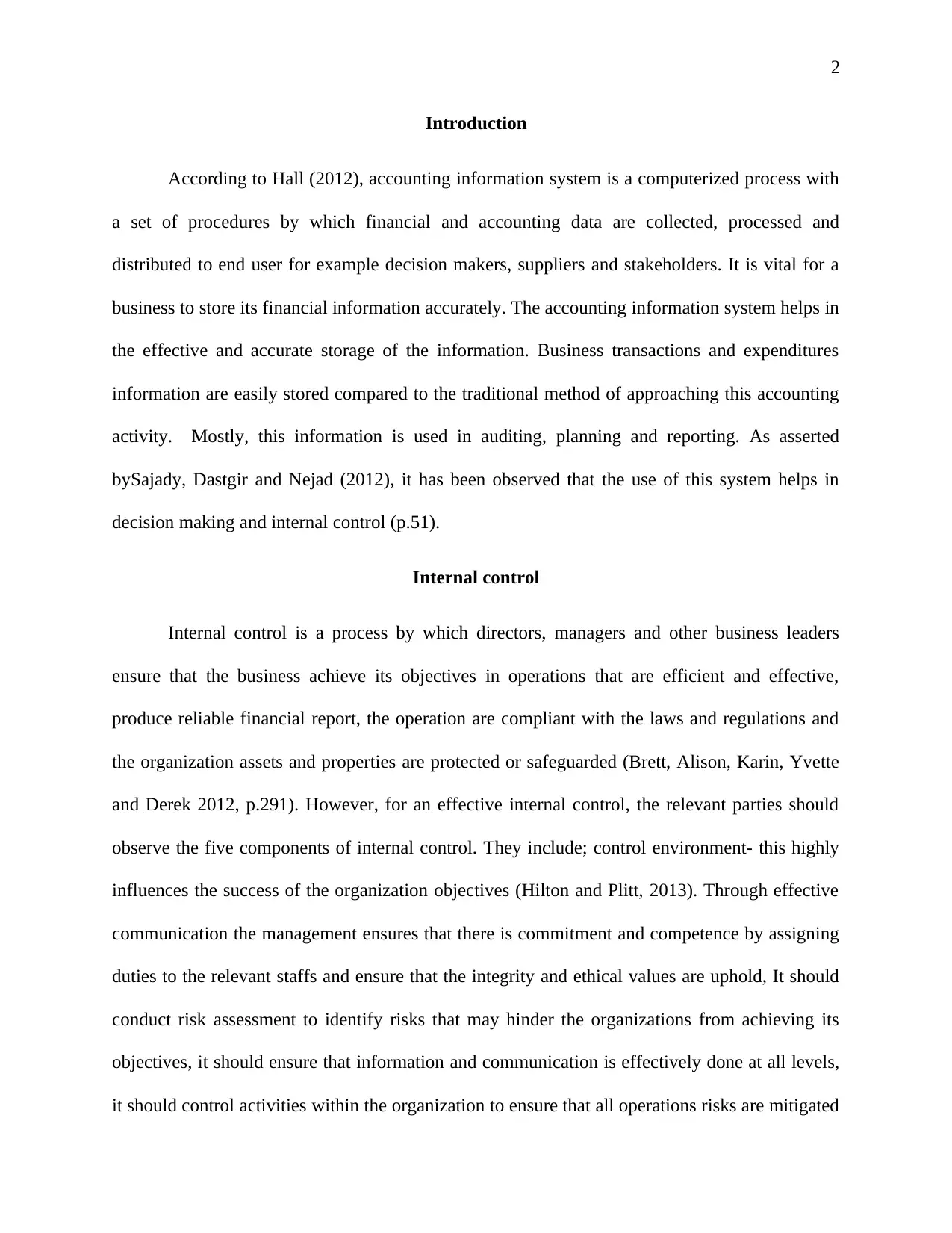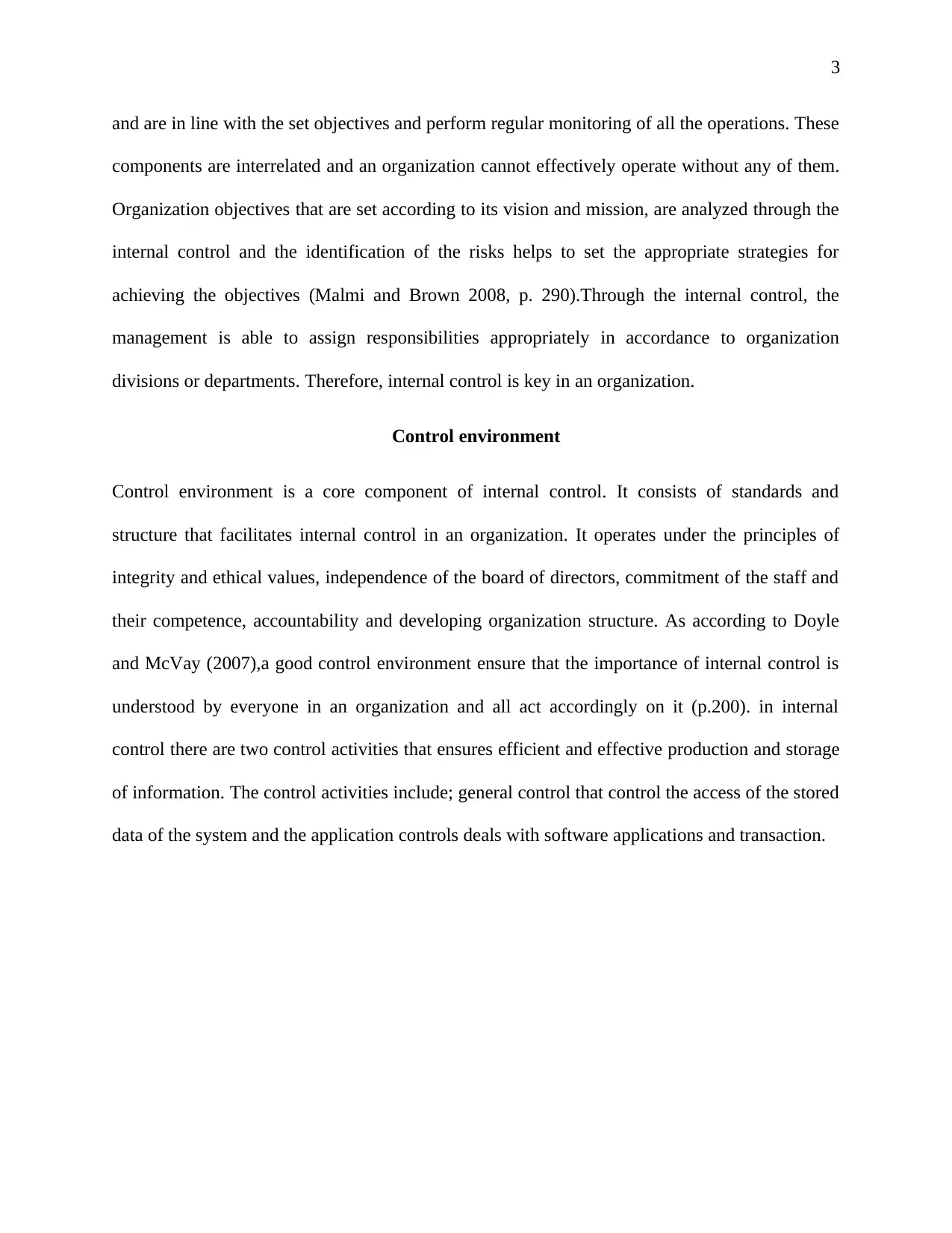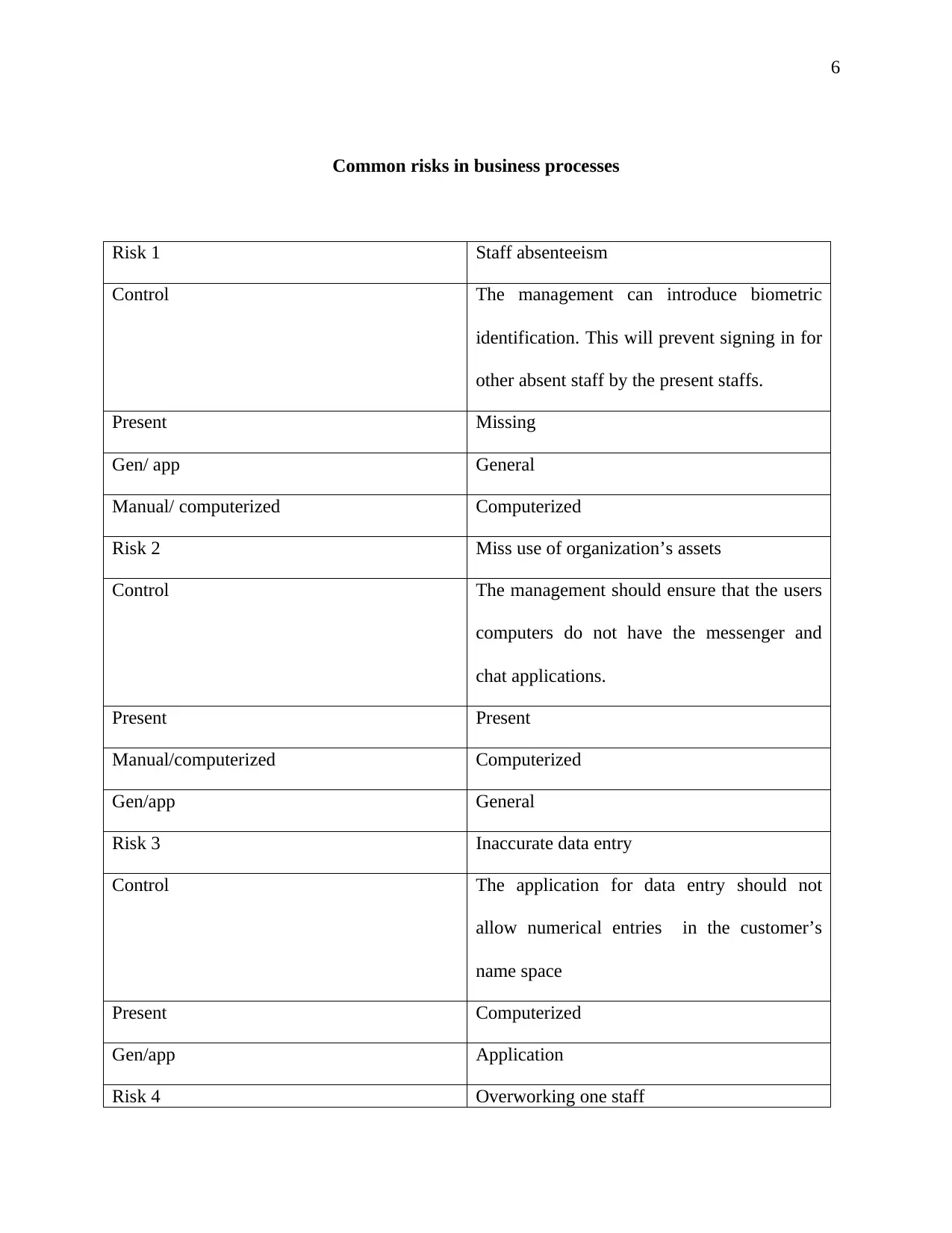Comprehensive Report on Internal Control in Accounting Systems
VerifiedAdded on 2021/06/14
|8
|1169
|213
Report
AI Summary
This report examines internal control within organizations, focusing on accounting information systems and their importance in ensuring accurate financial data storage, as highlighted by Hall (2012). It defines internal control as a process ensuring operational efficiency, reliable financial reporting, and compliance with regulations, as described by Brett et al. (2012). The report details the five components of internal control: control environment, risk assessment, information and communication, control activities, and monitoring. It explores how these components, as discussed by Hilton and Plitt (2013), contribute to achieving organizational objectives and mitigating risks, as noted by Malmi and Brown (2008). The report also classifies various control activities, such as general and application controls, using examples like password protection and data validation. It identifies common business process risks, including staff absenteeism, asset misuse, and inaccurate data entry, along with potential control measures. The report references key academic sources, including Doyle and McVay (2007) and Sajady et al. (2012), to support its analysis.

1
INTERNAL CONTROL IN ORGANIZATIONS
Name
Course
Professor
Institution
Location of institution
Date
INTERNAL CONTROL IN ORGANIZATIONS
Name
Course
Professor
Institution
Location of institution
Date
Paraphrase This Document
Need a fresh take? Get an instant paraphrase of this document with our AI Paraphraser

2
Introduction
According to Hall (2012), accounting information system is a computerized process with
a set of procedures by which financial and accounting data are collected, processed and
distributed to end user for example decision makers, suppliers and stakeholders. It is vital for a
business to store its financial information accurately. The accounting information system helps in
the effective and accurate storage of the information. Business transactions and expenditures
information are easily stored compared to the traditional method of approaching this accounting
activity. Mostly, this information is used in auditing, planning and reporting. As asserted
bySajady, Dastgir and Nejad (2012), it has been observed that the use of this system helps in
decision making and internal control (p.51).
Internal control
Internal control is a process by which directors, managers and other business leaders
ensure that the business achieve its objectives in operations that are efficient and effective,
produce reliable financial report, the operation are compliant with the laws and regulations and
the organization assets and properties are protected or safeguarded (Brett, Alison, Karin, Yvette
and Derek 2012, p.291). However, for an effective internal control, the relevant parties should
observe the five components of internal control. They include; control environment- this highly
influences the success of the organization objectives (Hilton and Plitt, 2013). Through effective
communication the management ensures that there is commitment and competence by assigning
duties to the relevant staffs and ensure that the integrity and ethical values are uphold, It should
conduct risk assessment to identify risks that may hinder the organizations from achieving its
objectives, it should ensure that information and communication is effectively done at all levels,
it should control activities within the organization to ensure that all operations risks are mitigated
Introduction
According to Hall (2012), accounting information system is a computerized process with
a set of procedures by which financial and accounting data are collected, processed and
distributed to end user for example decision makers, suppliers and stakeholders. It is vital for a
business to store its financial information accurately. The accounting information system helps in
the effective and accurate storage of the information. Business transactions and expenditures
information are easily stored compared to the traditional method of approaching this accounting
activity. Mostly, this information is used in auditing, planning and reporting. As asserted
bySajady, Dastgir and Nejad (2012), it has been observed that the use of this system helps in
decision making and internal control (p.51).
Internal control
Internal control is a process by which directors, managers and other business leaders
ensure that the business achieve its objectives in operations that are efficient and effective,
produce reliable financial report, the operation are compliant with the laws and regulations and
the organization assets and properties are protected or safeguarded (Brett, Alison, Karin, Yvette
and Derek 2012, p.291). However, for an effective internal control, the relevant parties should
observe the five components of internal control. They include; control environment- this highly
influences the success of the organization objectives (Hilton and Plitt, 2013). Through effective
communication the management ensures that there is commitment and competence by assigning
duties to the relevant staffs and ensure that the integrity and ethical values are uphold, It should
conduct risk assessment to identify risks that may hinder the organizations from achieving its
objectives, it should ensure that information and communication is effectively done at all levels,
it should control activities within the organization to ensure that all operations risks are mitigated

3
and are in line with the set objectives and perform regular monitoring of all the operations. These
components are interrelated and an organization cannot effectively operate without any of them.
Organization objectives that are set according to its vision and mission, are analyzed through the
internal control and the identification of the risks helps to set the appropriate strategies for
achieving the objectives (Malmi and Brown 2008, p. 290).Through the internal control, the
management is able to assign responsibilities appropriately in accordance to organization
divisions or departments. Therefore, internal control is key in an organization.
Control environment
Control environment is a core component of internal control. It consists of standards and
structure that facilitates internal control in an organization. It operates under the principles of
integrity and ethical values, independence of the board of directors, commitment of the staff and
their competence, accountability and developing organization structure. As according to Doyle
and McVay (2007),a good control environment ensure that the importance of internal control is
understood by everyone in an organization and all act accordingly on it (p.200). in internal
control there are two control activities that ensures efficient and effective production and storage
of information. The control activities include; general control that control the access of the stored
data of the system and the application controls deals with software applications and transaction.
and are in line with the set objectives and perform regular monitoring of all the operations. These
components are interrelated and an organization cannot effectively operate without any of them.
Organization objectives that are set according to its vision and mission, are analyzed through the
internal control and the identification of the risks helps to set the appropriate strategies for
achieving the objectives (Malmi and Brown 2008, p. 290).Through the internal control, the
management is able to assign responsibilities appropriately in accordance to organization
divisions or departments. Therefore, internal control is key in an organization.
Control environment
Control environment is a core component of internal control. It consists of standards and
structure that facilitates internal control in an organization. It operates under the principles of
integrity and ethical values, independence of the board of directors, commitment of the staff and
their competence, accountability and developing organization structure. As according to Doyle
and McVay (2007),a good control environment ensure that the importance of internal control is
understood by everyone in an organization and all act accordingly on it (p.200). in internal
control there are two control activities that ensures efficient and effective production and storage
of information. The control activities include; general control that control the access of the stored
data of the system and the application controls deals with software applications and transaction.
⊘ This is a preview!⊘
Do you want full access?
Subscribe today to unlock all pages.

Trusted by 1+ million students worldwide

4
Classification of control activities
Option Classification Explanation
a) Employees have a
password to gain
access to the system.
General This is a type of control that
ensures that the organization
staffs use the system for the
right purpose and not for
personal benefits. This helps
the management to protect
the assets of the organization
b) When sales are
entered the system
retrieves customer
details based on the
customer number
Application This is a type of application
control that is done at the
point of input. It ensures that
the data inputted into the
system is accurate and
correct. This helps to avoid
misrepresentation of data that
can cause irregularities and
make the information
incredible.
c) A check is performed
to identify if all
cheques can be
accounted for
Application This control activity is
performed to ensure that the
data entry was done correctly.
This ensure that the data in
Classification of control activities
Option Classification Explanation
a) Employees have a
password to gain
access to the system.
General This is a type of control that
ensures that the organization
staffs use the system for the
right purpose and not for
personal benefits. This helps
the management to protect
the assets of the organization
b) When sales are
entered the system
retrieves customer
details based on the
customer number
Application This is a type of application
control that is done at the
point of input. It ensures that
the data inputted into the
system is accurate and
correct. This helps to avoid
misrepresentation of data that
can cause irregularities and
make the information
incredible.
c) A check is performed
to identify if all
cheques can be
accounted for
Application This control activity is
performed to ensure that the
data entry was done correctly.
This ensure that the data in
Paraphrase This Document
Need a fresh take? Get an instant paraphrase of this document with our AI Paraphraser

5
the cheque is true and serves
the intended purpose. This
control is performed by the
application control
d) Systems development
is subject to signoff
by the CIO before it
can take place.
General This control is done to
prevent fraud from the system
developers who can
intentionally add malicious
software that can lead to
fraud or improper functioning
of the system according to the
organization objective.
e) Virus definitions are
updated daily
General This control ensures that the
computer security of an
organization is secure. It
protects it from viruses that
can poses risk to the
organization’s information
which can affect the
reporting, auditing and
budgeting processes.
the cheque is true and serves
the intended purpose. This
control is performed by the
application control
d) Systems development
is subject to signoff
by the CIO before it
can take place.
General This control is done to
prevent fraud from the system
developers who can
intentionally add malicious
software that can lead to
fraud or improper functioning
of the system according to the
organization objective.
e) Virus definitions are
updated daily
General This control ensures that the
computer security of an
organization is secure. It
protects it from viruses that
can poses risk to the
organization’s information
which can affect the
reporting, auditing and
budgeting processes.

6
Common risks in business processes
Risk 1 Staff absenteeism
Control The management can introduce biometric
identification. This will prevent signing in for
other absent staff by the present staffs.
Present Missing
Gen/ app General
Manual/ computerized Computerized
Risk 2 Miss use of organization’s assets
Control The management should ensure that the users
computers do not have the messenger and
chat applications.
Present Present
Manual/computerized Computerized
Gen/app General
Risk 3 Inaccurate data entry
Control The application for data entry should not
allow numerical entries in the customer’s
name space
Present Computerized
Gen/app Application
Risk 4 Overworking one staff
Common risks in business processes
Risk 1 Staff absenteeism
Control The management can introduce biometric
identification. This will prevent signing in for
other absent staff by the present staffs.
Present Missing
Gen/ app General
Manual/ computerized Computerized
Risk 2 Miss use of organization’s assets
Control The management should ensure that the users
computers do not have the messenger and
chat applications.
Present Present
Manual/computerized Computerized
Gen/app General
Risk 3 Inaccurate data entry
Control The application for data entry should not
allow numerical entries in the customer’s
name space
Present Computerized
Gen/app Application
Risk 4 Overworking one staff
⊘ This is a preview!⊘
Do you want full access?
Subscribe today to unlock all pages.

Trusted by 1+ million students worldwide

7
Control The customer assistant should be assigned the
role of entering the customers details before
handing the orders to John
Present Missing
Gen/app General
Manual/computerized Manual
References
Control The customer assistant should be assigned the
role of entering the customers details before
handing the orders to John
Present Missing
Gen/app General
Manual/computerized Manual
References
Paraphrase This Document
Need a fresh take? Get an instant paraphrase of this document with our AI Paraphraser

8
Brett Considine, Alison Parkes, Karin Olesen, Yvette Blount and Derek Speer 2012, Accounting
Information Systems - understanding business processes, 4, pp. 289-333
Doyle, J., Ge, W. and McVay, S., 2007. Determinants of weaknesses in internal control over
financial reporting. Journal of accounting and Economics, 44(1-2), pp.193-223.
Hall, J.A., 2012. Accounting information systems. Cengage Learning.
Hilton, R.W. and Platt, D.E., 2013. Managerial accounting: creating value in a dynamic
business environment.McGraw-Hill Education. Viewed 14th may 2018
http://lib.hpu.edu.vn/handle/123456789/22157>
Malmi, T. and Brown, D.A., 2008. Management control systems as a package—Opportunities,
challenges and research directions. Management accounting research, 19(4), pp.287-300.
Sajady, H., Dastgir, M. and Nejad, H.H., 2012. Evaluation of the effectiveness of accounting
information systems. International Journal of Information Science and Management (IJISM),
6(2), pp.49-59.
Brett Considine, Alison Parkes, Karin Olesen, Yvette Blount and Derek Speer 2012, Accounting
Information Systems - understanding business processes, 4, pp. 289-333
Doyle, J., Ge, W. and McVay, S., 2007. Determinants of weaknesses in internal control over
financial reporting. Journal of accounting and Economics, 44(1-2), pp.193-223.
Hall, J.A., 2012. Accounting information systems. Cengage Learning.
Hilton, R.W. and Platt, D.E., 2013. Managerial accounting: creating value in a dynamic
business environment.McGraw-Hill Education. Viewed 14th may 2018
http://lib.hpu.edu.vn/handle/123456789/22157>
Malmi, T. and Brown, D.A., 2008. Management control systems as a package—Opportunities,
challenges and research directions. Management accounting research, 19(4), pp.287-300.
Sajady, H., Dastgir, M. and Nejad, H.H., 2012. Evaluation of the effectiveness of accounting
information systems. International Journal of Information Science and Management (IJISM),
6(2), pp.49-59.
1 out of 8
Related Documents
Your All-in-One AI-Powered Toolkit for Academic Success.
+13062052269
info@desklib.com
Available 24*7 on WhatsApp / Email
![[object Object]](/_next/static/media/star-bottom.7253800d.svg)
Unlock your academic potential
Copyright © 2020–2025 A2Z Services. All Rights Reserved. Developed and managed by ZUCOL.





